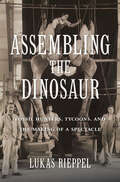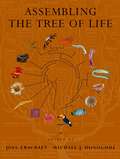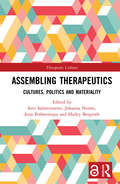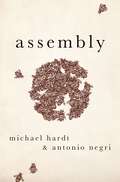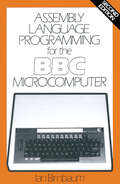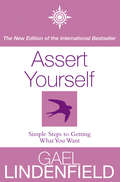- Table View
- List View
Assembling the Dinosaur: Fossil Hunters, Tycoons, and the Making of a Spectacle
by Lukas RieppelLukas Rieppel shows how dinosaurs gripped the popular imagination and became emblems of America’s industrial power and economic prosperity during the Gilded Age. Spectacular fossils were displayed in museums financed by North America’s wealthiest tycoons, to cement their reputation as both benefactors of science and fierce capitalists.
Assembling the Tree of Life
by Joel Cracraft Michael J. DonoghueThis edited volume is provides an authoritative synthesis of knowledge about the history of life. All the major groups of organisms are treated, by the leading workers in their fields. With sections on: The Importance of Knowing the Tree of Life; The Origin and Radiation of Life on Earth; The Relationships of Green Plants; The Relationships of Fungi; and The Relationships of Animals. This book should prove indispensable for evolutionary biologists, taxonomists, ecologists interested in biodiversity, and as a baseline sourcebook for organismic biologists, botanists, and microbiologists. An essential reference in this fundamental area.
Assembling Therapeutics: Cultures, Politics and Materiality (Therapeutic Cultures)
by Suvi Salmenniemi Johanna Nurmi Inna Perheentupa Harley BergrothThe Open Access version of this book, available at https://www.taylorfrancis.com/books/e/9781351233392, has been made available under a Creative Commons Attribution-Non Commercial-No Derivatives 4.0 license. This volume examines the ways in which people engage with therapeutic practices, such as life coaching, mindfulness, complementary and alternative medicine, sex and relationship counselling, spiritual healing and self-tracking. It investigates how human and non-human actors, systems of thought and practice are assembled and interwoven in therapeutic engagements, and traces the situated, material and political dimensions of these engagements. By focusing on lived experiences through ethnographically informed case studies, the book elucidates the diverse forms, meanings and embodied effects of therapeutic engagements in different settings, as well as their potential for both oppressive and subversive social change. In this way, Assembling Therapeutics contributes to our understanding of multiple modes of healing, self-knowledge and power in contemporary societies.
Assembling Therapeutics: Cultures, Politics and Materiality (Therapeutic Cultures)
The Open Access version of this book, available at https://www.taylorfrancis.com/books/e/9781351233392, has been made available under a Creative Commons Attribution-Non Commercial-No Derivatives 4.0 license. This volume examines the ways in which people engage with therapeutic practices, such as life coaching, mindfulness, complementary and alternative medicine, sex and relationship counselling, spiritual healing and self-tracking. It investigates how human and non-human actors, systems of thought and practice are assembled and interwoven in therapeutic engagements, and traces the situated, material and political dimensions of these engagements. By focusing on lived experiences through ethnographically informed case studies, the book elucidates the diverse forms, meanings and embodied effects of therapeutic engagements in different settings, as well as their potential for both oppressive and subversive social change. In this way, Assembling Therapeutics contributes to our understanding of multiple modes of healing, self-knowledge and power in contemporary societies.
Assembly (Heretical Thought)
by Michael Hardt Antonio NegriIn recent years "leaderless" social movements have proliferated around the globe, from North Africa and the Middle East to Europe, the Americas, and East Asia. Some of these movements have led to impressive gains: the toppling of authoritarian leaders, the furthering of progressive policy, and checks on repressive state forces. They have also been, at times, derided by journalists and political analysts as disorganized and ineffectual, or suppressed by disoriented and perplexed police forces and governments who fail to effectively engage them. Activists, too, struggle to harness the potential of these horizontal movements. Why have the movements, which address the needs and desires of so many, not been able to achieve lasting change and create a new, more democratic and just society? Some people assume that if only social movements could find new leaders they would return to their earlier glory. Where, they ask, are the new Martin Luther Kings, Rudi Dutschkes, and Stephen Bikos? With the rise of right-wing political parties in many countries, the question of how to organize democratically and effectively has become increasingly urgent. Although today's leaderless political organizations are not sufficient, a return to traditional, centralized forms of political leadership is neither desirable nor possible. Instead, as Michael Hardt and Antonio Negri argue, familiar roles must be reversed: leaders should be responsible for short-term, tactical action, but it is the multitude that must drive strategy. In other words, if these new social movements are to achieve meaningful revolution, they must invent effective modes of assembly and decision-making structures that rely on the broadest democratic base. Drawing on ideas developed through their well-known Empire trilogy, Hardt and Negri have produced, in Assembly, a timely proposal for how current large-scale horizontal movements can develop the capacities for political strategy and decision-making to effect lasting and democratic change. We have not yet seen what is possible when the multitude assembles.
Assembly (Heretical Thought)
by Michael Hardt Antonio NegriIn recent years "leaderless" social movements have proliferated around the globe, from North Africa and the Middle East to Europe, the Americas, and East Asia. Some of these movements have led to impressive gains: the toppling of authoritarian leaders, the furthering of progressive policy, and checks on repressive state forces. They have also been, at times, derided by journalists and political analysts as disorganized and ineffectual, or suppressed by disoriented and perplexed police forces and governments who fail to effectively engage them. Activists, too, struggle to harness the potential of these horizontal movements. Why have the movements, which address the needs and desires of so many, not been able to achieve lasting change and create a new, more democratic and just society? Some people assume that if only social movements could find new leaders they would return to their earlier glory. Where, they ask, are the new Martin Luther Kings, Rudi Dutschkes, and Stephen Bikos? With the rise of right-wing political parties in many countries, the question of how to organize democratically and effectively has become increasingly urgent. Although today's leaderless political organizations are not sufficient, a return to traditional, centralized forms of political leadership is neither desirable nor possible. Instead, as Michael Hardt and Antonio Negri argue, familiar roles must be reversed: leaders should be responsible for short-term, tactical action, but it is the multitude that must drive strategy. In other words, if these new social movements are to achieve meaningful revolution, they must invent effective modes of assembly and decision-making structures that rely on the broadest democratic base. Drawing on ideas developed through their well-known Empire trilogy, Hardt and Negri have produced, in Assembly, a timely proposal for how current large-scale horizontal movements can develop the capacities for political strategy and decision-making to effect lasting and democratic change. We have not yet seen what is possible when the multitude assembles.
Assembly and its Other in German Romantic Literature and Thought: The Inexhaustible Gathering (Romantic Reconfigurations: Studies in Literature and Culture 1780-1850 #16)
This collection of essays turns on a shift in Romantic studies from viewing wholeness as an absolute value to critiquing it as a limiting construction. Wholeness and its concomitant sense of harmony, rather than a natural given, is a construct that was assembled and disassembled, theorized and criticized, by diverse authors and artists in a wide variety of disciplines and socio-historical contexts, and instrumentalized for diverse purposes. The plurality of these constructions – that Goethe’s Urpflanze, for example, is not synonymous with Friedrich Schlegel’s universal progressive poetry – is but one manifestation of how “assembly” strives but fails to be absolute. The “other” of assembly referenced in the title suggests two divergent but inseparable tendencies: firstly, how a construction can take on the appearance of a natural given; and secondly, how assemblages of wholeness harbor within themselves their own principle of disarticulation. These two tendencies underlie the “inexhaustible” character of Romantic “gatherings”. As a construction passes itself off as nature, the natural fails to account for itself as a whole. The scope of this volume encompasses the establishment, mapping, and interrogation of assembly and its other in German Romanticism through interdisciplinary studies on literature, aesthetics, philosophy, drama, music, synaesthesia, mathematics, science, and exploration.List of contributors: Beate Allert, Frederick Burwick, Alexis B. Smith, Margaret Strair, Christina Weiler, Joshua Wilner.
Assembly and Reliability of Lead-Free Solder Joints
by John H. Lau Ning-Cheng LeeThis book focuses on the assembly and reliability of lead-free solder joints. Both the principles and engineering practice are addressed, with more weight placed on the latter. This is achieved by providing in-depth studies on a number of major topics such as solder joints in conventional and advanced packaging components, commonly used lead-free materials, soldering processes, advanced specialty flux designs, characterization of lead-free solder joints, reliability testing and data analyses, design for reliability, and failure analyses for lead-free solder joints. Uniquely, the content not only addresses electronic manufacturing services (EMS) on the second-level interconnects, but also packaging assembly on the first-level interconnects and the semiconductor back-end on the 3D IC integration interconnects. Thus, the book offers an indispensable resource for the complete food chain of electronics products.
Assembly Automation and Product Design (Manufacturing Engineering And Materials Processing Ser.)
by Geoffrey BoothroydAddressing design for automated and manual assembly processes, Assembly Automation and Product Design, Second Edition examines assembly automation in parallel with product design. The author enumerates the components, processes, performance, and comparative economics of several types of automatic assembly systems. He provides information on equipme
Assembly Language Programming: ARM Cortex-M3
by Vincent MahoutARM designs the cores of microcontrollers which equip most "embedded systems" based on 32-bit processors. Cortex M3 is one of these designs, recently developed by ARM with microcontroller applications in mind. To conceive a particularly optimized piece of software (as is often the case in the world of embedded systems) it is often necessary to know how to program in an assembly language. This book explains the basics of programming in an assembly language, while being based on the architecture of Cortex M3 in detail and developing many examples. It is written for people who have never programmed in an assembly language and is thus didactic and progresses step by step by defining the concepts necessary to acquiring a good understanding of these techniques.
Assembly Language Programming: ARM Cortex-M3
by Vincent MahoutARM designs the cores of microcontrollers which equip most "embedded systems" based on 32-bit processors. Cortex M3 is one of these designs, recently developed by ARM with microcontroller applications in mind. To conceive a particularly optimized piece of software (as is often the case in the world of embedded systems) it is often necessary to know how to program in an assembly language. This book explains the basics of programming in an assembly language, while being based on the architecture of Cortex M3 in detail and developing many examples. It is written for people who have never programmed in an assembly language and is thus didactic and progresses step by step by defining the concepts necessary to acquiring a good understanding of these techniques.
Assembly Language Step-by-Step: Programming with Linux
by Jeff DuntemannThe eagerly anticipated new edition of the bestselling introduction to x86 assembly language The long-awaited third edition of this bestselling introduction to assembly language has been completely rewritten to focus on 32-bit protected-mode Linux and the free NASM assembler. Assembly is the fundamental language bridging human ideas and the pure silicon hearts of computers, and popular author Jeff Dunteman retains his distinctive lighthearted style as he presents a step-by-step approach to this difficult technical discipline. He starts at the very beginning, explaining the basic ideas of programmable computing, the binary and hexadecimal number systems, the Intel x86 computer architecture, and the process of software development under Linux. From that foundation he systematically treats the x86 instruction set, memory addressing, procedures, macros, and interface to the C-language code libraries upon which Linux itself is built. Serves as an ideal introduction to x86 computing concepts, as demonstrated by the only language directly understood by the CPU itself Uses an approachable, conversational style that assumes no prior experience in programming of any kind Presents x86 architecture and assembly concepts through a cumulative tutorial approach that is ideal for self-paced instruction Focuses entirely on free, open-source software, including Ubuntu Linux, the NASM assembler, the Kate editor, and the Gdb/Insight debugger Includes an x86 instruction set reference for the most common machine instructions, specifically tailored for use by programming beginners Woven into the presentation are plenty of assembly code examples, plus practical tips on software design, coding, testing, and debugging, all using free, open-source software that may be downloaded without charge from the Internet.
Assembly Language Step-by-Step: Programming with Linux
by Jeff DuntemannThe eagerly anticipated new edition of the bestselling introduction to x86 assembly language The long-awaited third edition of this bestselling introduction to assembly language has been completely rewritten to focus on 32-bit protected-mode Linux and the free NASM assembler. Assembly is the fundamental language bridging human ideas and the pure silicon hearts of computers, and popular author Jeff Dunteman retains his distinctive lighthearted style as he presents a step-by-step approach to this difficult technical discipline. He starts at the very beginning, explaining the basic ideas of programmable computing, the binary and hexadecimal number systems, the Intel x86 computer architecture, and the process of software development under Linux. From that foundation he systematically treats the x86 instruction set, memory addressing, procedures, macros, and interface to the C-language code libraries upon which Linux itself is built. Serves as an ideal introduction to x86 computing concepts, as demonstrated by the only language directly understood by the CPU itself Uses an approachable, conversational style that assumes no prior experience in programming of any kind Presents x86 architecture and assembly concepts through a cumulative tutorial approach that is ideal for self-paced instruction Focuses entirely on free, open-source software, including Ubuntu Linux, the NASM assembler, the Kate editor, and the Gdb/Insight debugger Includes an x86 instruction set reference for the most common machine instructions, specifically tailored for use by programming beginners Woven into the presentation are plenty of assembly code examples, plus practical tips on software design, coding, testing, and debugging, all using free, open-source software that may be downloaded without charge from the Internet.
Assembly-Line Balancing under Demand Uncertainty (Gabler Theses)
by Celso Gustavo Stall SikoraAssembly lines are productive systems, which are very efficient for homogeneous products. In the automotive industry, an assembly line is used in the production of several vehicle variants, including numerous configurations, options, and add-ins. As a result, assembly lines must be at the same time specialized to provide high efficiency, but also flexible to allow the mass customization of the vehicles. In this book, the planning of assembly lines for uncertain demand is tackled and optimization algorithms are offered for the balancing of such lines. Building an assembly line is a commitment of several months or even years, it is understandable that the demand will fluctuate during the lifetime of an assembly line. New products are developed, others are removed from the market, and the decision of the final customer plays a role on the immediate demand. Therefore, the variation and uncertainty of the demand must be accounted for in an assembly line. In this book, methods dealing with random demand or random production sequence are presented, so that the practitioners can plan more robust and efficient production systems.
Assembly Line Balancing under Uncertain Task Time and Demand Volatility (Engineering Applications of Computational Methods #8)
by Yuchen LiThis book introduces several mathematical models in assembly line balancing based on stochastic programming and develops exact and heuristic methods to solve them. An assembly line system is a manufacturing process in which parts are added in sequence from workstation to workstation until the final assembly is produced. In an assembly line balancing problem, tasks belonging to different product models are allocated to workstations according to their processing times and precedence relationships among tasks. It incorporates two features, uncertain task times, and demand volatility, separately and simultaneously, into the conventional assembly line balancing model. A real-life case study related to the mask production during the COVID-19 pandemic is presented to illustrate the application of the proposed framework and methodology. The book is intended for graduate students who are interested in combinatorial optimizations in manufacturing with uncertain input.
Assembly Line Design: The Balancing of Mixed-Model Hybrid Assembly Lines with Genetic Algorithms (Springer Series in Advanced Manufacturing)
by Brahim Rekiek Alain DelchambreEfficient assembly line design is a problem of considerable industrial importance. Assembly Line Design will be bought by technical personnel working in design, planning and production departments in industry as well as managers in industry who want to learn more about concurrent engineering. This book will also be purchased by researchers and postgraduate students in mechanical, manufacturing or micro-engineering.
Assembly Line Planning and Control
by Nick T. ThomopoulosAssembly Line Planning and Control describes the basic fundamentals of assembly lines for single model lines, mixed model make-to-stock lines, mixed model make-to-order lines and for one-station assembly. The book shows how to select the quantity of units to schedule for a shift duration, compute the number of operators needed on a line, set the conveyor speed, coordinate the main line with sub-assembly lines, assign the work elements to the operators on the line, sequence the models down the line, sequence the jobs down the line, calculate the part and component requirements for a line and for each station, determine the replenish needs of the parts and components from the suppliers, compute the similarity between the models being produced and show applications, use learning curves to estimate time and costs of assembly, and measure the efficiency of the line. The material is timeless and the book will never become obsolete. The author presents solutions with easy-to-understand numerical examples that can be applied to real-life applications.
Assembly of Enveloped RNA Viruses
by Monique Dubois-Dalcq Kathryn V. Holmes Bernard RentierThis book is a collection of critical reviews about a diverse group of virus families with two features in common: the stable repository of genetic information in each virus is RNA, and each virus modifies and appropriates a particular patch of the eukaryotic cell membrane system to complete its structure. The reviews take the reader from the level of virus genome structure and expression through the quaternary interactions between virus-specified elements and cellular components that cooperate to produce virus particles. There are spectacular illustrations in this volume, but it is much more than a picture gallery. Reading widely in this book can be an effective antidote to overspecialization: in these pages, you are likely to learn much about viruses and about cells that you didn't know before; you'll discover illuminating parallels between diverse virus families; you'll come away with a sharpened awareness of important things that are still to be learned. Memphis, Tenn. , Summer 1984 David W. Kingsbury Preface This book was written at the suggestion of Dr. David W. Kingsbury made at a work shop on viruses organized by the Multiple Sclerosis Society in Aspen, Colorado, U. S. A. , three years ago. Originally, we had thought to focus on the morphological aspects of viral assembly. Later, during our discussions on the process of budding of enveloped RNA viruses, it became evident that we should include biochemical data in our review and correlate them with the structural aspects of virus maturation.
Assembly of the Vasculature and Its Regulation (Cardiovascular Molecular Morphogenesis)
by Robert J. TomanekThe overall scope of this new series will be to evolve an understanding of the genetic basis of (1) how early mesoderm commits to cells of a heart lineage that progressively and irreversibly assemble into a segmented, primary heart tube that can be remodeled into a four-chambered organ, and (2) how blood vessels are derived and assembled both in the heart and in the body. Our central aim is to establish a four-dimensional, spatiotemporal foundation for the heart and blood vessels that can be genetically dissected for function and mechanism. Since Robert DeHaan's seminal chapter "Morphogenesis of the Vertebrate Heart" published in Organogenesis (Holt Rinehart & Winston, NY) in 1965, there have been surprisingly few books devoted to the subject of cardiovascular mor phogenesis, despite the enormous growth of interest that occurred nationally and internationally. Most writings on the subject have been scholarly compilations of the proceedings of major national or international symposia or multiauthored volumes, often without a specific theme. What is missing are the unifying concepts that can make sense out of a burgeoning database of facts. The Editorial Board of this new series believes the time has come for a book series dedicated to cardio vascular morphogenesis that will serve not only as an important archival and didac tic reference source for those who have recently come into the field but also as a guide to the evolution of afield that is clearly coming of age.
Assembly Processes: Finishing, Packaging, and Automation
by Richard CrowsonToday's fast-paced manufacturing culture demands a handbook that provides how-to, no-holds-barred, no-frills information. Completely revised and updated, the Handbook of Manufacturing Engineering is now presented in four volumes. Keeping the same general format as the first edition, this second edition not only provides more information but makes i
Assembly with Robots
by Tony. OwenIn the western world, economic logic (and need) has replaced the indentured craftsman by computer controlled machining centres within manufacturing industries. The same rationale is the incentive behind the development of robots that are technically capable of performing assembly tasks, and the inevitable, albeit slow, adoption of these robots by the manufacturing industries. This book is based upon the author's knowledge and first hand experience of the manufacturing industries of North America and the UK in general, and the UK's robotics industry in particular. The general and specific implications of per forming an assembly task robotically are discussed, the majority of which are not specific to anyone sector of the manufactur ing industry, nor to any particular size of product being manu factured. This book should be of interest to those who are interested in or involved with the use of robots for assembly. The 'veils of mystic' and misinformation on robots and the assembly process are subsequently removed.
Assert Yourself: Simple Steps To Getting What You Want
by Gael LindenfieldNow in ebook format for the first time.
